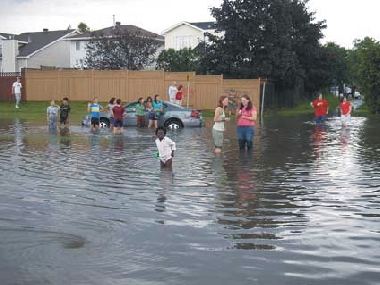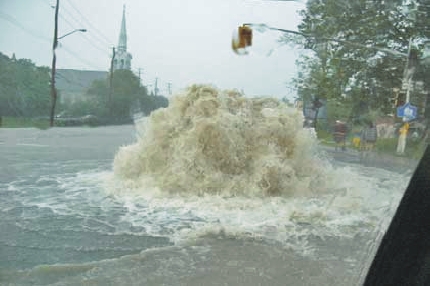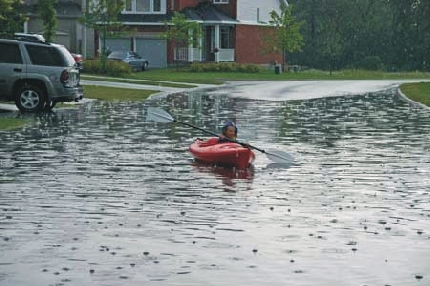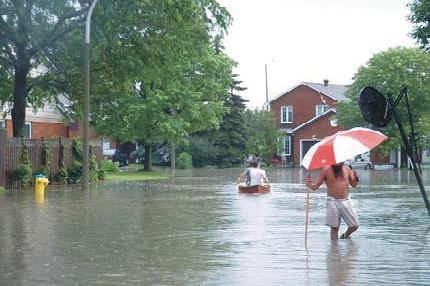Orleans flood, July 3, 2006
(City drainage nightmares continue)
(City drainage nightmares continue)
The July 3rd thunderstorm, the second such storm to hit Orleans in the past 8 years, dropped about 70 millimetres of rain over an hour causing many streets and basements to be flooded. These types of floods are likely to become more numerous as the City continues to allow development to encroach into the natural drainage systems in various parts of the City. The costs of repairing such flood damage should convince decision makers that protecting the natural drainage system make good financial and environmental sense.
|
From Ottawa Metro, July 5: Richard
Hewitt, deputy city manager of public works, said yesterday
there’s nothing wrong with drainage in the area. It was simply
overwhelmed by a heavier than usual rainfall, he said. “None of our
systems can handle that kind of event,” said Hewitt. Such comments could be valid in
older parts of the City, but surely not in such a recently built
community as Orleans. |
|
 |
Modern stormwater management
involves
consideration of both "major system flow" (i.e. overland flow), and
"minor system flow" (i.e. in storm sewers). The minor system is
normally required to convey rain storms up to the "5-10 year event",
and what isn't captured in the minor system (i.e. what is draining
through storm sewers) is converyed along the major system (i.e. running
along roads, swales, ditches, tributaries, rivers etc.) This
"major/minor system" approach has been around for years, what happened
in Orleans?
|
 |
This
geyser is
caused by water rushing from storm sewers (minor drainage system)
sitting higher in elevation compared to the sewer running along the
street. As is evidenced in Kanata West, the City continues to underestimate the importance of protecting the natural drainage system. Ottawa is somewhat unique in that most municipalities in other parts of the province don't eliminate / fill in many of the small tributaries during urbanization as does the City. The City's approach all too often sees the replacement of natural drainage functions with engineered storm sewers with the result that the minor system is burdened with flows that in other municipalities would have already discharged into a major system. |
 |
The
reason for the elimination of the
tributaries is to maximize the use of land for development. The
tributaries are replaced by storm
sewers on the basis of findings in non-calibrated engineering models
that are prepared by the developer's engineering consultants. |
 |
Will things improve in Orleans,
not likely! The Official Plan shows that a future employment area
is to be built south of Innes Road. This is the same general area
of the Belcourt drainage system. There is likely another
100 acres or more of intense development south of Innes Road that will
need to drain through the Belcourt drainage system - a system that,
based on observation during and after the July 3 storm is already
over-taxed. This additional development area will exacerbate
existing problems, and is likely to increase the frequency in which
flooding will occur. |
The City is currently developing a Stormwater Management Strategy, perhaps the best advise for new areas of development is to provide more protection to natural drainage systems in order to prevent more Orleans type floods.